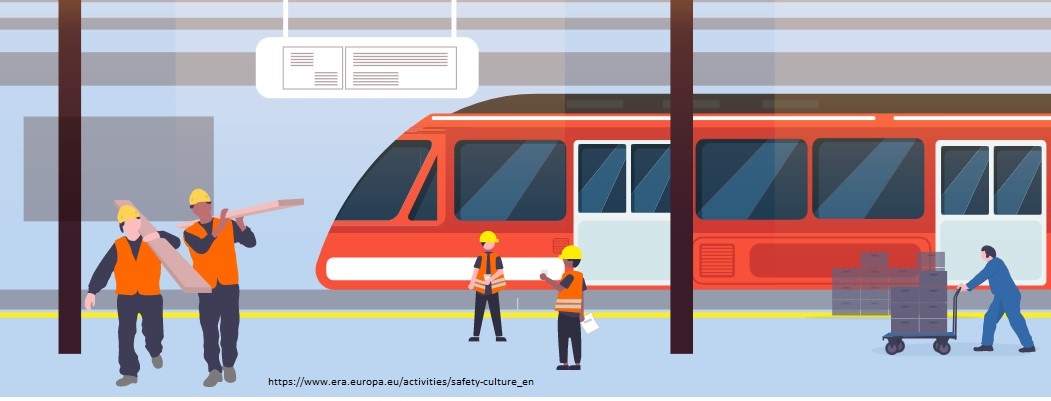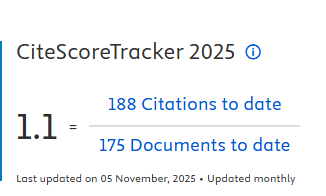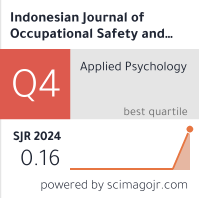Working Period Relationship, Safety Knowledge, and Safety Performance among the Construction Workforce of Light Rail Transit

Downloads
Introduction: Safety performance refers to an individual safety behavior that can be determined by two groups of factors, environmental and individual. Each company has its own safety performance program for its employees. The company's role in occupational health and safety is to create a positive organizational climate by implementing an occupational safety and health management system. This relates to the organization's commitment to prevent accidents and occupational diseases, and to improve the level of work productivity. This research aims to analyze the relationship between the Working Period, safety knowledge, and safety performance among the workforce of the LRT construction project. Method: This research used the quantitative research approach which emphasizes data in the form of numbers and processing by statistical methods. The research design was observational with a cross-sectional approach. The population of this research was 97 respondents who filled in the questionnaires. The independent variables were Working Period relationship and safety knowledge while the dependent variable was safety performance. Result: The results show that the Working Period has a negative relationship with safety performance. Safety knowledge has a positive relationship with safety performance. The individual characteristics of the Jabodebek LRT station construction project are based on a Working Period of < 1 year for 38 people. Conclusion: Working Period has a weak relationship with safety performance and has criteria which relate to negative relationships. However, the relationship between safety knowledge and safety performance has a positive and significant relationship because the broad knowledge of safety of the employees improves their safety performance.
Bannai, A. and Tamakoshi, A. (2014) ‘The Association between Long Working Hours and Health : A Systematic Review of Epidemiological Evidence', Scandinavian Journal of Work, Environment and Health, 40(1), pp. 5–18.
Barbaranelli, C., Petitta, L. and Probst, T. M. (2015) ‘Does Safety Climate Predict Safety Performance in Italy and the USA? Cross-Cultural Validation of a Theoretical Model of Safety Climate', Accident Analysis and Prevention, 77(April), pp. 35–44.
BPJS Ketenagakerjaan (2019) Laporan Keuangan Konsolidasian BPJS Ketenagakerjaan Tahun 2018. Jakarta: BPJS Ketenagakerjaan.
Chahyadhi, B. (2019) Hubungan Faktor Kepemimpinan Keselamatan, Gaya Kepemimpinan, Dan Motivasi Kerja Dengan Kinerja Keselamatan Kerja Pada PT Japfa Comfeed Indonesia Gedangan Sidoarjo. Thesis. Surabaya : Faculty of Public Health, Universitas Airlangga.
Dwiatmoko, H. (2019) ‘The Role of Railway Industry in Indonesia's Economic Growth', in Proceedings of the International Conference on Industrial Engineering and Operations Management, p. 2483.
Fauziah, T., Kawatu, P. and Mandagie, C. (2019) ‘Hubungan Antara Masa Kerja dan Beban Kerja dengan Kinerja pada Petugas Pemadan Kebakaran Kota Manado', Kesmas, 7(5), pp. 1–7.
Gunawan, I. and Mudayana, A. A. (2016) ‘Hubungan Antara Pengetahuan,Sikap dan Motivasi dengan Perilaku Penggunaan Alat Pelindung Diri pada Pekerja Bagian Produksi PT. Katingan Indah Utama, Kabupaten Kota Waringin Timur, Provinsi Kalimantan Tengah', Unnes Journal of Public Health, 5(4), pp. 336–347.
Hendrayani (2020) ‘Pengaruh Tingkat Pendidikan dan Pengalaman Kerja terhadap Kinerja Karyawan Pada PD. Pasar Makassar Raya, Kota Makassar', Jurnal Ekonomix, 8(1), pp. 1–12.
James, P. and Walters, D. (2019) ‘Health & Safety at Work: Time for Change', Institute of Employment Rights Journal, 2(1), pp. 58–85.
Jebb, S. (2015) Reducing Workplace Safety Incidents: Bridging the Gap Between Safety Culture Theory and Practice. Thesis. Queensland:Faculty of Health Queensland University of Technology.
Koesindratmono, F. (2012) ‘Hubungan antara Masa Kerja dengan Pemberdayaan Psikologis pada Karyawan PT. Perkebunan Nusantara X (Persero)', Insan Media Psikologi, 13(2), pp. 50–57.
Koesyanto, H. (2013) ‘Masa Kerja dan Sikap Kerja Duduk terhadap Nyeri Punggung', KESMAS Jurnal Kesehatan Masyarakat, 9(1), pp. 9–14.
Mohammadi, A., Tavakolana, M. and Khosravi, Y. (2018) ‘Factors Influencing Safety Performance on Construction Projects: A Review', Safety Science, 109(37), pp. 382–397.
Nadhim, E. A. et al. (2018) ‘Investigating the Relationships between Safety Climate and Safety Performance Indicators in Retrofitting Works', Construction Economics and Building, 18(2), pp. 110–129.
Nugroho, D. F., Yakin, K. and Bustamin, M. O. (2018) ‘Kajian Risiko Kecelakaan Kerja Terhadap Manajemen Kesehatan Dan Keselamatan Kerja (K3) (Pembangunan Villa Grand Sinensis PT. Wahana Karya Wijaya)', Ge-STRAM: Jurnal Perencanaan dan Rekayasa Sipil, 1(2), pp. 95–101.
Paksi, H. K. I. (2018) Mediasi pengetahuan Keselamatan dan Iklim Keselamatan pada Pengaruh Praktik Manajemen Keselamatan pada kinerja Keselamatan. Undergraduate Thesis.Surakarta:Faculty of Economics and Islamic Business, Surakarta State Islamic Institute.
Panggabean, R. A. P. and Nursin, A. (2019) ‘Analisis Penerapan Manajemen K3 pada Proyek Stasiun LRT Kampung Rambutan', Prosiding Seminar Nasional Teknik Sipil, 1(1), pp. 329–336.
Prabarini, P. and Suhariadi, F. (2018) ‘Iklim Keselamatan Kerja dan Big Five Personality Sebagai Prediktor Perilaku Keselamatan Karyawan', Jurnal Psikologi Teori dan Terapan, 9(1), pp. 1–16.
Pramadhan, M. A., Yusuf, M. and Iskandar, H. (2019) ‘GAP Analisis Pemenuhan Elemen Pada Sistem Manajemen Keselamatan Pertambangan Berdasarkan Peraturan Menteri ESDM NOMOR 38 Tahun 2014 DI PT Bukit Asam Tbk Unit Pertambangan Tanjung Enim '', Jurnal Pertambangan, 3(3), pp. 20–26.
Rosalita, N. A., Ratmawati, D. and Agustina, T. S. (2015) ‘Mediasi Safety Knowledge Dan Safety Motivation Pada Pengaruh Safety Management Practices Terhadap Safety Performance Karyawan Bagian Produksi PT.Petrokimia Gresik', Jurnal Manajemen Teori dan Terapan| Journal of Theory and Applied Management, 8(3), pp. 201–215.
Rusdiana (2017) Pengaruh kepemimpinan keselamatan & iklim keselamatan pada kinerja keselamatan karyawan dengan pengetahuan keselamatan. Undergraduate Thesis.Surabaya:Faculty of Psychology, Airlangga University.
Sari, K. R. T. P. (2017) ‘Analisis Faktor yang Mempengaruhi Kinerja Keselamatan Menggunakan Metode Partial Component Regression (PCR) dan Non-Iterative Linear Partial Least Square', POLITEKNOSAINS, XVI(1), pp. 41–47.
Septiani, V. M. (2015) ‘Pengaruh Pelatihan, Pengalaman Kerja, dan Promosi Jabatan Terhadap Kinerja Karyawan Pada Badan Pemeriksa Keuangan Republik Indonesia Perwakilan Sulawesi Utara', Jurnal EMBA: Jurnal Riset Ekonomi, Manajemen, Bisnis dan Akuntansi, 3(3), pp. 992–1002.
Septiningsih, E. (2017) Penguatan Masa Kerja dalam Meningkatkan Kepatuhan Penggunaan Alat Pelindung Diri pada Petugas Kebersihan. Undergraduate Thesis. Yogjakarta. Faculty of Medicine and Health Sciences,Muhammadiyah University of Yogyakarta.
Setiawan, A. and Febriyanto, K. (2020) ‘Hubungan Masa Kerja dengan Kepatuhan Penggunaan APD pada Pekerja di Galangan Kapal Samarinda', Borneo Student Research, 2(1), pp. 433–439.
Siagian, M. and Wasiman, W. (2020) ‘Model Hubungan Kepemimpinan , Stres Kerja , Komitmen Kepuasan Kerja Sebagai Variabel Intervening Perusahaan Jasa Pengiriman KArgo di Kota Batam', Khazanah Ilmu Berazam, 3(1), pp. 19–31.
Siregar, A. N. and Saridewi, T. R. (2010) ‘Hubungan antara Motivasi dan Budaya Kerja dengan Kinerja Penyuluh Pertanian di Kabupaten Subang, Provinsi Jawa Barat', Jurnal Penyuluhan Pertanian, 5(1), pp. 24–35.
Sulistyorini, A., Rahfiludin, M. Z. and Suroto, S. (2019) ‘Determinan Perilaku Keselamatan Kerja: Peran Faktor Personal Penjamah Makanan di Warung Lesehan Malioboro', JST (Jurnal Sains Terapan), 5(2), pp. 77–85.
Syarifah, D. and Adiati, R. P. (2018) ‘Safety Performance pada Pekerja Berisiko Tinggi Ditinjau dari Kepribadian, Pengetahuan dan Motivasi Keselamatan Kerja', INSAN Jurnal Psikologi dan Kesehatan Mental, 3(1), pp. 23–30.
Tucker, P. and Folkard, S. (2012) Working Time , Health and Safety : A Research Synthesis Paper. Conditions. Geneva : International Labour Office.
Vinodkumar, M. N. and Bhasi, M. (2010) ‘Safety Management Practices and Safety Behaviour: Assessing the Mediating Role of Safety Knowledge and Motivation', Accident Analysis and Prevention, 42(6), pp. 2082–2093.
Wardhani, R. A. N. and Refianto (2019) ‘Meningkatkan Prestasi Belajar Siswa Melalui Penerapan Model Pembelajaran Multiple Intelligences Di Smk Negeri 4 Jember', JPEK (Jurnal Pendidikan Ekonomi dan Kewirausahaan), 3(2), pp. 129–139.
Zahoor, H. et al. (2015) ‘A Research Framework for Investigating the Relationship between Safety Climate and Safety Performance in the Construction of Multi-storey Buildings in Pakistan', Procedia Engineering, 118(2015), pp. 581–589.
Copyright (c) 2022 The Indonesian Journal Of Occupational Safety and Health

This work is licensed under a Creative Commons Attribution-NonCommercial-ShareAlike 4.0 International License.

In order to be accepted and published by The Indonesian Journal of Occupational Safety and Health, Author(s) who submit an article should complete all the review process. The copyright of received articles assigned to the The Indonesian Journal of Occupational Safety and Health and Department of Safety and Health, Universitas Airlangga as publishers of the journal. The intended copyright includes the rights to publish articles in various forms (including reprints).
The Editorial Team of The Indonesian Journal Of Occupational Safety and Health and Department of Safety and Health strive to ensure that no errors occur in the articles that have been published, both data errors and statements in the article.
Users of this website will be licensed to use materials from this website following the Creative Commons Attribution-NonCommercial-ShareAlike 4.0 International License. No fees charged. Please use the materials accordingly.
------------------------------------------------------------------------------------------------------------------------------------------------------------------------------------------
Attribution ” You must give appropriate credit, provide a link to the license, and indicate if changes were made. You may do so in any reasonable manner, but not in any way that suggests the licensor endorses you or your use.
NonCommercial ” You may not use the material for commercial purposes.
ShareAlike ” If you remix, transform, or build upon the material, you must distribute your contributions under the same license as the original.







 How to Submit Articles in OJS
How to Submit Articles in OJS

























